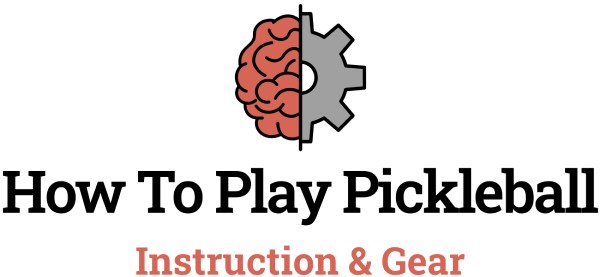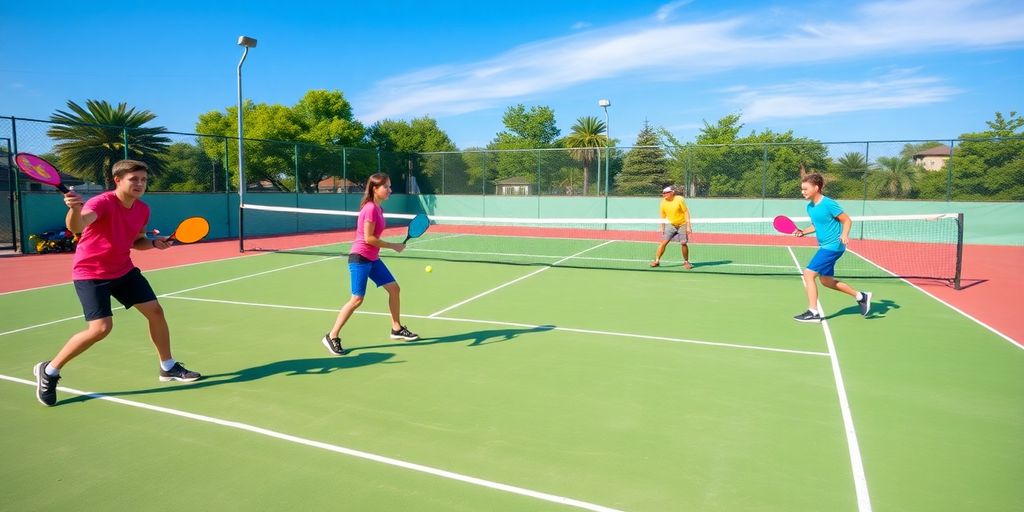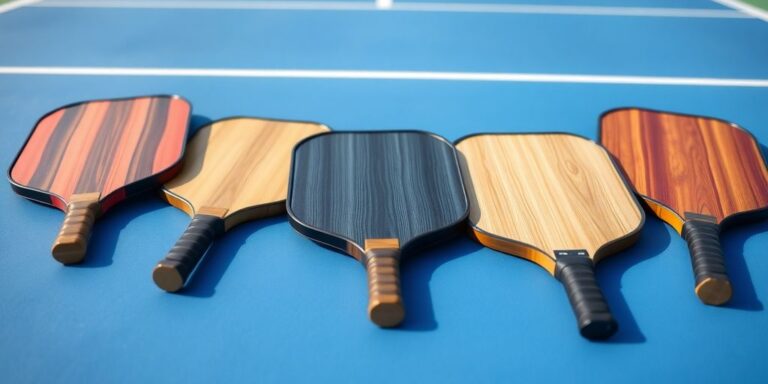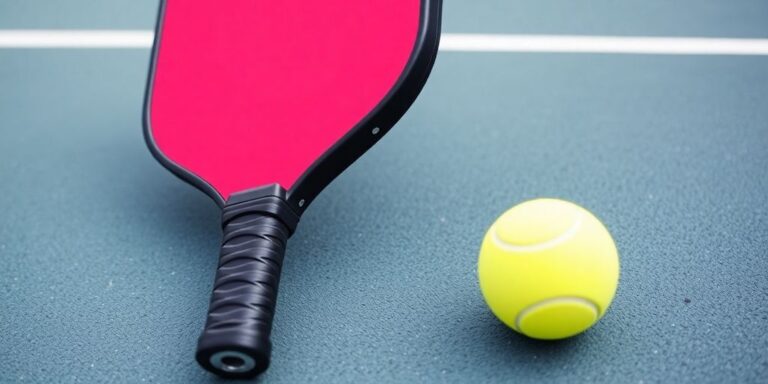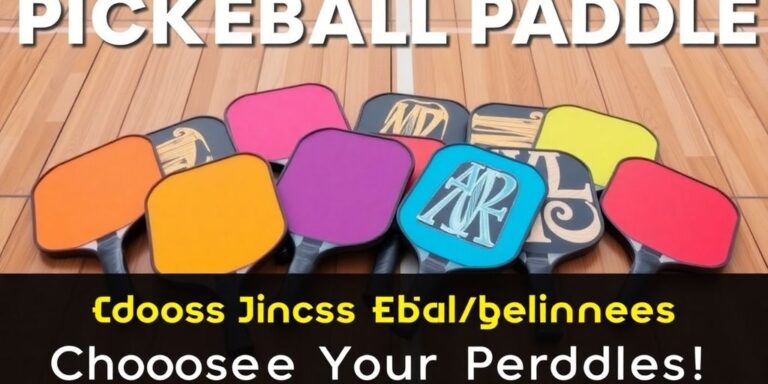If you’ve ever thought about mixing up your game and wondered, “Can you play pickleball on a tennis court?” the answer is a resounding yes! With some simple adjustments, you can transform a tennis court into a suitable space for pickleball. This article will break down what you need to know about the differences between the two sports, how to adapt a tennis court for pickleball, and what equipment you’ll need to get started. So, whether you’re a seasoned tennis player or new to pickleball, there’s plenty of fun to be had!
Key Takeaways
- Pickleball can be played on a tennis court with some modifications.
- Adjustments include changing court markings, net height, and adding a non-volley zone.
- You’ll need specific equipment like paddles and balls for pickleball.
- Basic pickleball rules still apply, but may need tweaks for court size.
- Safety measures, such as proper footwear and player spacing, are important.
Understanding Pickleball and Tennis Differences
What’s The Difference Between Pickleball And Tennis?
Okay, so you’re thinking about playing pickleball on a tennis court? First, let’s break down the key differences between these two sports. They might both involve rackets and a net, but that’s pretty much where the similarities end. Pickleball is often described as a mix of tennis, badminton, and ping-pong, and that’s actually a pretty accurate description.
Think of it this way:
- Tennis uses a larger court, pickleball uses a smaller one.
- Tennis rackets are bigger and heavier, pickleball paddles are smaller and lighter.
- Tennis balls bounce a lot, pickleball balls… not so much.
And the rules? Totally different. In pickleball, you’ve got that funky non-volley zone (the "kitchen"), and the serving rules are unique. It’s a whole different ball game, literally.
How Does Court Size Affect Gameplay?
Court size is a HUGE deal when you’re talking about pickleball versus tennis. A tennis court is significantly larger than a pickleball court. This difference in size impacts everything from movement to strategy. In tennis, you’re covering a lot of ground, hitting powerful serves, and chasing down those long shots. Pickleball? It’s a more compact game, requiring quicker reflexes, dinking skills, and strategic placement.
Here’s a quick comparison:
| Feature | Tennis Court | Pickleball Court |
|---|---|---|
| Length | 78 feet | 44 feet |
| Width (Singles) | 27 feet | 20 feet |
| Width (Doubles) | 36 feet | 20 feet |
Because the pickleball court is smaller, the game tends to be faster-paced, with more shots at the net. You don’t have as much time to react, so those quick reaction times are super important. When you play pickleball on a tennis court, you really notice the extra space. It can be an advantage if you’re used to tennis, but it also changes the dynamic of the game.
Playing pickleball on a tennis court can feel a bit like playing basketball on a football field. There’s just a lot of extra space that isn’t really used in the traditional way. This can lead to some interesting strategic adjustments, but it’s something to keep in mind.
Equipment Variations Between The Two Sports
Let’s talk gear. You can’t just grab your tennis racket and expect to dominate on the pickleball court. The equipment is different, and it matters. Tennis rackets are larger, heavier, and designed for power. Pickleball paddles are smaller, lighter, and made for control. The balls are also completely different. Tennis balls are fuzzy and bouncy, while pickleball balls are plastic with holes and don’t bounce nearly as much. Using the right equipment is important for both performance and safety.
Here’s a quick rundown:
- Rackets/Paddles: Tennis rackets are larger with strings; pickleball paddles are solid and smaller.
- Balls: Tennis balls are fuzzy and bounce high; pickleball balls are plastic with holes and bounce less.
- Shoes: While you can wear tennis shoes for pickleball, specialized pickleball shoes offer better lateral support.
So, if you’re serious about playing pickleball, even on a tennis court, invest in the right pickleball paddles. It’ll make a difference.
Adapting A Tennis Court For Pickleball
Modifying Court Markings
Okay, so you want to play pickleball on a tennis court? First thing’s first: those lines have GOT to be sorted out. A tennis court is way bigger than a pickleball court, so you can’t just start whacking the ball around without some serious confusion. The key is to clearly mark the pickleball boundaries within the tennis court.
Here’s the deal:
- Use different colored tape (blue or green works well) to mark the pickleball lines. Don’t use white, because, well, tennis lines.
- A standard pickleball court is 20 feet wide and 44 feet long. Keep that in mind when you’re taping.
- You can use the existing tennis court lines for some of the pickleball court, like the center service line. That makes things a little easier.
Honestly, the hardest part is making sure everything is straight. I used a measuring tape and a level, and I still managed to mess it up a little. But hey, it’s all about having fun, right?
If you want to get serious about it, you could even paint the lines, but tape is way less permanent. This guide provides straightforward instructions for converting a tennis court.
Adjusting Net Height
Next up: the net. Tennis nets are taller than pickleball nets, so you’ll need to lower it somehow. The official height for a pickleball net is 36 inches at the sidelines and 34 inches in the middle.
Here are a few ways to make it happen:
- Adjustable Straps: Some tennis nets have adjustable straps. If you’re lucky, you can just loosen them until the net is at the right height.
- DIY Rig: If your net isn’t adjustable, you can get creative. I’ve seen people use ropes, bungee cords, or even just weights to pull the net down. Just make sure it’s secure and doesn’t pose a tripping hazard.
- Temporary Net: You can buy a portable pickleball net and set it up on the tennis court. This is the easiest option, but it also costs the most.
Creating A Non-Volley Zone
Alright, last but not least: the non-volley zone, also known as "the kitchen." This is the area closest to the net where you can’t volley the ball (hit it out of the air). It’s a crucial part of pickleball, so you gotta mark it.
Here’s how:
- The non-volley zone extends 7 feet from the net on both sides.
- Use the same colored tape you used for the court lines to mark the kitchen.
- Make sure the lines are clear and easy to see. You don’t want any arguments about whether someone was in the kitchen or not.
Once you’ve got the lines, the net, and the kitchen sorted, you’re pretty much good to go. Grab your paddle and a ball, and get ready to play some pickleball! If you’re looking for local pickleball courts, there are resources available to help you find them.
Essential Equipment For Playing Pickleball

What Equipment Do You Need?
Okay, so you’re thinking about playing pickleball, maybe even on a tennis court? Awesome! First things first, let’s talk gear. You can’t just grab a tennis racket and expect to dominate. Pickleball requires its own set of tools.
Here’s the lowdown:
- Pickleball Paddle: This is your weapon of choice. They’re smaller and lighter than tennis rackets. You’ll find different materials like graphite, composite, or wood. Graphite and composite are generally preferred for better control and power. I’d suggest trying a few out to see what feels best in your hand.
- Pickleball Balls: These are plastic, with holes, and they don’t bounce like tennis balls. Outdoor balls are heavier and have smaller holes to combat wind, while indoor balls are lighter with larger holes. Make sure you’re using the right ball for where you’re playing.
- Net (Optional): If you’re playing on a tennis court, you might need to lower the net or use a portable pickleball net. Some tennis courts already have lines painted for pickleball, but not all do. If you’re serious, investing in a portable net is a good idea. You can find inexpensive court lines that can be transported anywhere.
- Court Lines (Optional): If the tennis court doesn’t have pickleball lines, you can use temporary court lines. These are usually made of rubber or plastic and are easy to set up and take down.
Don’t skimp on the equipment you need such as the nets and lines. You want to get years out of this equipment and you will get horrible quality if you try to save money and buy from a one-off merchant.
Choosing The Right Footwear
Footwear is super important. You can’t just wear any old sneakers. You need shoes that provide good lateral support, since pickleball involves a lot of side-to-side movement. Tennis shoes or court shoes are your best bet. Running shoes usually don’t offer enough stability and could lead to ankle injuries. Trust me, I learned that the hard way. Here’s a quick comparison:
| Feature | Running Shoes | Court Shoes |
|---|---|---|
| Lateral Support | Low | High |
| Sole | Designed for forward motion | Designed for multi-directional movement |
| Ankle Stability | Lower | Higher |
Using Pickleball-Specific Gear
While you can technically play pickleball with some makeshift equipment, using gear designed specifically for the sport will make a huge difference. For example, pickleball paddles are much smaller and lightweight compared to tennis rackets.
Here’s a few things to consider:
- Paddle Weight: Lighter paddles are easier to maneuver, while heavier paddles offer more power. It’s a personal preference thing.
- Grip Size: Make sure the grip feels comfortable in your hand. Too small, and you’ll be squeezing too hard. Too big, and you’ll lose control.
- Protective Eyewear: While not mandatory, eye protection is a good idea, especially if you’re playing with people who hit the ball hard. A stray ball to the eye can ruin your day.
Rules For Playing Pickleball On A Tennis Court
Basic Pickleball Rules Overview
Okay, so you’re thinking about playing pickleball on a tennis court? Awesome! The good news is that the basic rules of pickleball still apply. You’ve still got your two-bounce rule, your non-volley zone (the "kitchen"), and your underhand serve. But let’s quickly recap the essentials:
- Serve diagonally, starting from the right side if your score is even, and the left if it’s odd.
- The serve must clear the net and land in the opposite service box.
- After the serve, each team must let the ball bounce once before volleying (the two-bounce rule).
- You can only volley the ball if you’re standing outside the non-volley zone.
Remember, pickleball is usually played to 11 points, and you have to win by two. It’s a game of patience, strategy, and a surprising amount of finesse. Don’t be afraid to try some unique pickleball techniques!
Adapting Rules For Court Size
Now, here’s where things get a little interesting. Tennis courts are bigger than standard pickleball courts, so you might need to make some adjustments. The biggest thing is marking the pickleball court boundaries. If you’re using temporary lines (tape or chalk), make sure they’re clearly visible. If you’re playing with permanent lines, you’ll need to mentally adjust to the smaller space. This can affect your strategy, especially when it comes to dinking and court coverage. You might find that the ball bounces differently on the tennis court surfaces too.
- Consider using cones or markers to define the corners of the pickleball court.
- Be aware of the extra space outside the pickleball lines – it’s out of bounds!
- Communicate clearly with your partner about who’s covering which area.
Understanding Service And Scoring
The scoring system in pickleball can be a bit confusing at first, but it’s crucial to understand. Only the serving team can score points. If the serving team faults (e.g., hits the ball out, doesn’t clear the net, volleys in the kitchen), the serve goes to the other team. In doubles, each player on the serving team gets a chance to serve before the serve goes to the opposing team, except for the very first serve of the game, where only one player gets to serve. Make sure everyone knows the score before each serve to avoid any arguments. If you’re looking to join a local pickleball league, understanding the scoring is a must.
Here’s a quick breakdown:
- Games are typically played to 11 points, win by 2.
- Only the serving team can score.
- The server announces the score before each serve (e.g., "3-2-1" means the serving team has 3 points, the receiving team has 2, and it’s the first server’s turn).
Safety Considerations When Playing Pickleball
Ensuring A Safe Playing Surface
Okay, so you’re thinking about playing pickleball on a tennis court? Awesome! But before you start smashing those pickleballs, let’s talk safety. First thing’s first: the court itself. Make sure the tennis court surface is in good shape. We’re talking about cracks, uneven spots, or anything that could trip you up.
- Check for cracks and repair them if possible.
- Sweep the court to remove any debris like leaves or pebbles.
- If the surface is slippery, consider using a non-slip coating.
I remember one time, I was so excited to play, I didn’t even look at the court. I ended up tripping over a crack and twisting my ankle. Not fun! Take a few minutes to inspect the court, it’s worth it.
Maintaining Proper Player Spacing
Pickleball courts are smaller than tennis courts, so things can get a little crowded. It’s super important to be aware of where your fellow players are to avoid collisions. Pickleball is played on a smaller court, so communication is key. Call out your shots, let people know where you’re moving, and try not to get too close for comfort.
- Communicate clearly with your partner and opponents.
- Be aware of your surroundings and other players’ positions.
- Avoid crowding the net or the non-volley zone.
Wearing Appropriate Footwear
This might seem obvious, but you’d be surprised how many people try to play in the wrong shoes. You need shoes that provide good support and traction, especially for those quick side-to-side movements. Running shoes? Nope. You want court shoes. Good lateral support is a must.
- Choose shoes designed for court sports.
- Ensure your shoes have good ankle support.
- Replace worn-out shoes to maintain traction.
Here’s a quick guide:
| Shoe Type | Best For… | Worst For… |
|---|---|---|
| Court Shoes | Pickleball, tennis, other court sports | Running, hiking |
| Running Shoes | Running, jogging | Court sports (lack lateral support) |
| Cross-Trainers | General workouts | Specialized court sports (less specific support) |
Transitioning From Tennis To Pickleball
So, you’re a tennis player thinking about trying pickleball? Awesome! While both sports involve racquets and a net, there are some key differences. It’s not just a smaller court; the whole vibe is different. Let’s talk about how to make that switch.
Tips For Tennis Players
Okay, first things first: forget trying to overpower everything. Tennis is often about power, but pickleball is more about placement and strategy. Think chess, not brute force. Here are a few things to keep in mind:
- Dinking is your friend: Get comfortable with those soft shots that land in the non-volley zone. It’s a game-changer.
- Court awareness is key: The pickleball court is smaller, so you need to adjust your positioning and movement. No more leisurely strolls to the baseline.
- Adjust your grip: A continental grip is common in pickleball, allowing for quick changes between forehand and backhand.
Practicing Unique Pickleball Techniques
Pickleball has some unique shots and strategies that tennis players might not be familiar with. The "kitchen" (non-volley zone) is a big one. You can’t volley in there, which changes the game significantly. The third shot drop is another crucial skill. It’s all about softening the ball so it lands softly in the kitchen, forcing your opponents to hit up. Practice these:
- The Third Shot Drop
- Dinking
- Volleying at the Net
Adjusting To Different Game Strategies
Tennis can be a very individual sport, even in doubles. Pickleball, especially doubles, is all about teamwork and communication. You need to be on the same page as your partner, anticipating their moves and covering the court effectively. Here’s the deal:
- Communicate constantly: Call out shots, let your partner know where you’re moving, and coordinate your strategy.
- Poach aggressively (but smartly): Look for opportunities to intercept shots at the net, but don’t leave your partner exposed.
- Be patient: Pickleball rallies can be long and drawn-out. Don’t get impatient and try to force a shot. Wait for the right opportunity. Understanding court sharing etiquette is also important when transitioning to pickleball.
It’s easy to get frustrated when you first start playing pickleball after playing tennis. The strategies are different, the court is smaller, and the game is generally faster-paced. Be patient with yourself, focus on learning the fundamentals, and don’t be afraid to ask for help from more experienced players. You’ll get the hang of it eventually, and you might even find that you enjoy pickleball more than tennis!
Using Public Tennis Courts For Pickleball

Can You Play Pickleball On Public Courts?
So, can you actually play pickleball on public tennis courts? The short answer is often yes, but it comes with some considerations. Many public tennis courts are now being used for pickleball, either with permanent lines added or with players bringing their own temporary nets and court markers. It really depends on the specific rules and regulations of your local parks and recreation department. Some places are super accommodating, while others might have restrictions or designated times for each sport. It’s always a good idea to check before you head out with your paddle.
Understanding Court Sharing Etiquette
Sharing is caring, right? When you’re using a public tennis court for pickleball, it’s super important to be mindful of tennis players and other pickleball enthusiasts. Here are a few things to keep in mind:
- Be respectful of scheduled court times. If there’s a sign-up system, follow it.
- Keep the noise level reasonable. Pickleball can be a noisy sport, but try to keep the yelling and cheering to a minimum, especially if there are other people nearby.
- Clean up after yourself. Make sure to take all your equipment and any trash with you when you leave.
Remember, we’re all just trying to enjoy the game. A little bit of courtesy can go a long way in making sure everyone has a good time. Being mindful of others while enjoying your game on public tennis courts is key.
Finding Local Facilities That Accommodate Both Sports
Okay, so how do you actually find places where you can play pickleball on a tennis court? Here are a few ideas:
- Check your local parks and recreation website. Many departments list the amenities available at each park, including whether or not tennis courts are lined for pickleball.
- Use online pickleball court finders. There are several websites and apps that can help you locate pickleball courts near you, including those on tennis courts.
- Ask around at local community centers and gyms. They may have information about nearby facilities that accommodate both sports. Networking and being proactive are great ways to find a pickleball partner in your area.
Adapting a tennis court for pickleball is easier than you think. You can even find pickleball court conversion kits to make the process smoother.
If you’re looking to play pickleball, public tennis courts can be a great option! Many of these courts are open to everyone and can easily be converted for pickleball games. Grab your paddle and some friends, and head to your local court for a fun time. Want to learn more about how to find and use these courts? Visit our website for tips and resources!
Final Thoughts on Playing Pickleball on Tennis Courts
So, can you play pickleball on a tennis court? Absolutely! With some simple adjustments, you can easily turn a tennis court into a pickleball court. It’s a great way to enjoy both sports without needing a separate space. Just remember to make those necessary changes to the court lines and net height, and keep safety in mind. Whether you’re a seasoned player or just starting out, this setup can bring a lot of fun and excitement. So grab your paddles, find a court, and give it a shot!
Frequently Asked Questions
Can you play pickleball on a tennis court?
Yes, you can play pickleball on a tennis court by making some adjustments to the court.
What are the main differences between pickleball and tennis?
Pickleball is played on a smaller court, has different equipment, and follows a unique scoring system compared to tennis.
How do you set up a tennis court for pickleball?
To set up a tennis court for pickleball, you need to change the court markings, lower the net, and create a no-volley zone.
What equipment do you need for pickleball?
To play pickleball, you need a pickleball paddle, balls, and proper shoes.
What are the basic rules for playing pickleball on a tennis court?
The rules are similar to regular pickleball, but you may need to adjust some rules for the smaller court size.
Are there any safety tips for playing pickleball?
Yes, make sure the court surface is safe, keep enough space between players, and wear the right shoes to avoid injuries.
